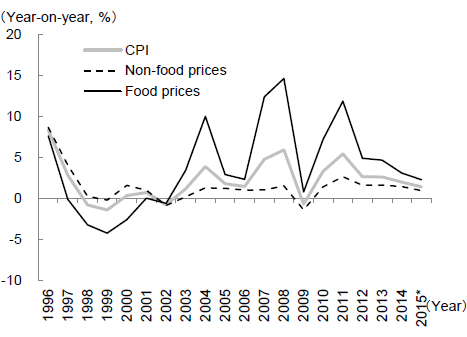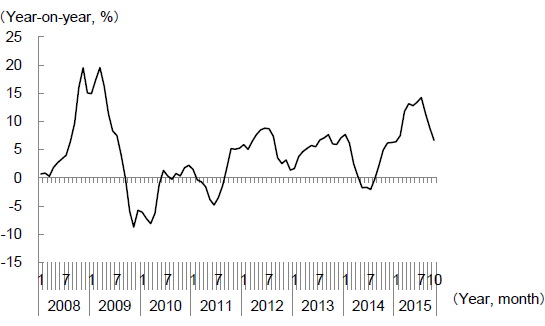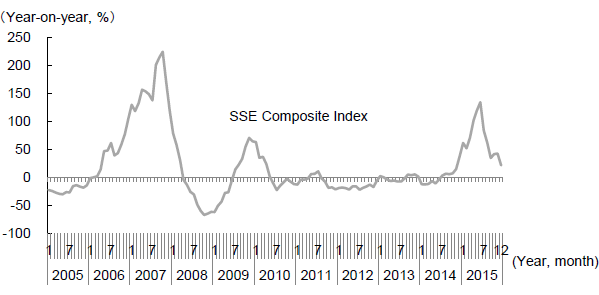In China, for a long time, growth in consumption remained lower than that in the gross domestic product (GDP), but now the situation has been reversed. This reflects the fact that the propensity to consume (the ratio of consumption to income) is no longer on a downward trend but is now moving upward. The propensity to consume seems to be boosted by a combination of factors, including wages increasing at a faster pace than GDP growth, changes in prices, such as the greater rise in food prices relative to non-food prices, appreciation of the renminbi, falling primary commodity prices, rising stock prices, and falling real interest rates.
Wages increasing at a faster pace than GDP growth
As the supply of labor has shifted from a state of excess to shortage in recent years, wages have increased at a faster pace than GDP growth (both in nominal terms), and the labor share of GDP (the percentage of GDP made up by labor income) is now on an upward trend after bottoming out in 2011. In general, the propensity to consume is inversely related to the income level, lower in the high-income group, and higher in the low-income group. If the income gap widens, income will become more concentrated in the high-income group that has a low propensity to consume, and this in turn will pull down the overall propensity to consume. On the other hand, if the income gap shrinks, the overall propensity to consume will rise. Workers with a lower level of income have a higher propensity to consume than those in the higher-income group with capital income. A rise in the labor share of GDP indicates a narrower income gap, and this is boosting consumption by causing the overall propensity to consume to rise.
Greater rise in food prices relative to non-food prices
The rate of increase in food prices has been consistently higher than that in non-food prices since 2002. The former reached 2.3% year-on-year in the period between January and November 2015 while the latter maintained at 1.0% year-on-year (Figure 1). The higher rise in food prices relative to non-food prices indicates a transfer of income from urban residents to farmers, thereby pushing up the overall propensity to consume by shrinking the income gap between rural residents and urban residents. In fact, the growth rate of the disposable income per rural resident from January to September 2015 was 8.1% year-on-year, which is much higher than that of urban residents (6.8% year-on-year). This shift was reflected in the growth rate of consumer spending per rural resident (9.3% year-on-year), which was also significantly higher than that of urban residents (5.4%). The growth rate of retail sales in rural areas (11.7% year-on-year) was also higher than that in urban areas (10.3%).

Appreciation of the renminbi
The effective exchange rate of the renminbi, which is the weighted average of the exchange rates of the renminbi against the currencies of China's major trading partners, has been rising since 2005 when China shifted to the managed floating rate system. The pace of appreciation of the renminbi in effective terms started to accelerate around mid-2014, reflecting the sharp depreciation of major currencies such as the euro and yen against the U.S. dollar. To put the brakes on the loss of export competitiveness stemming from the stronger renminbi, from August 11 to 13, 2015 the Chinese government devalued the exchange rate (midpoint rate) of the renminbi against the dollar by a total of 4.7%. However, the effective exchange rate of the renminbi is still significantly higher than the level from a year ago (Figure 2). Exports have become more expensive relative to imports due to the appreciation of the renminbi, and the resulting improvement in the terms of trade has led to an increase in consumption through higher real income.

Falling prices of primary commodities
China relies heavily on imports from abroad for its supply of primary commodities. Given a sluggish global economy, the prices of primary commodities such as oil have fallen sharply. By improving the terms of trade, this has raised the level of real income of Chinese consumers and boosted consumption, as in the case with the stronger renminbi.
Rising stock prices
The asset effect stemming from the changes in stock prices has had an impact on consumption. Although the Shanghai Stock Exchange (SSE) Composite Index, which rose sharply at one point, fell rapidly after peaking at 5,166 on June 12, 2015, it bottomed out at 2,977 on August 26, 2015. Since then, the SSE Composite Index has gradually picked up, and, as of the middle of December 2015, it was about 20% higher than its level from a year ago (Figure 3).

Falling real interest rates
China has been easing its monetary policy in an effort to boost economic growth. One such measure was to lower interest rates, with the benchmark one-year deposit rate being cut six times since November 2014 from 3.0% to 1.5%. Although the inflation rate also dropped during this time, the real interest rate (the nominal interest rate minus the inflation rate) has declined from the recent peak of 1.95% (January 2015) to 0% in November 2015 because the fall in the inflation rate has been smaller than that in deposit rates. The falling real interest rates indicate that it is more advantageous to increase consumption now than save for future consumption.
Together with the rapid growth of online shopping, these factors have contributed to the expansion of consumption, which, in turn, has put a floor under the economy's slowdown.
The original text in Japanese was posted on December 28, 2015.


